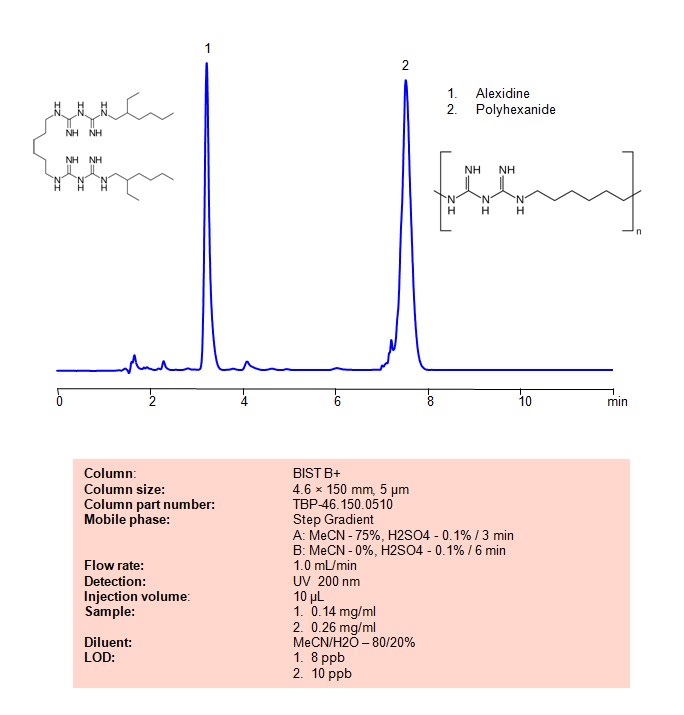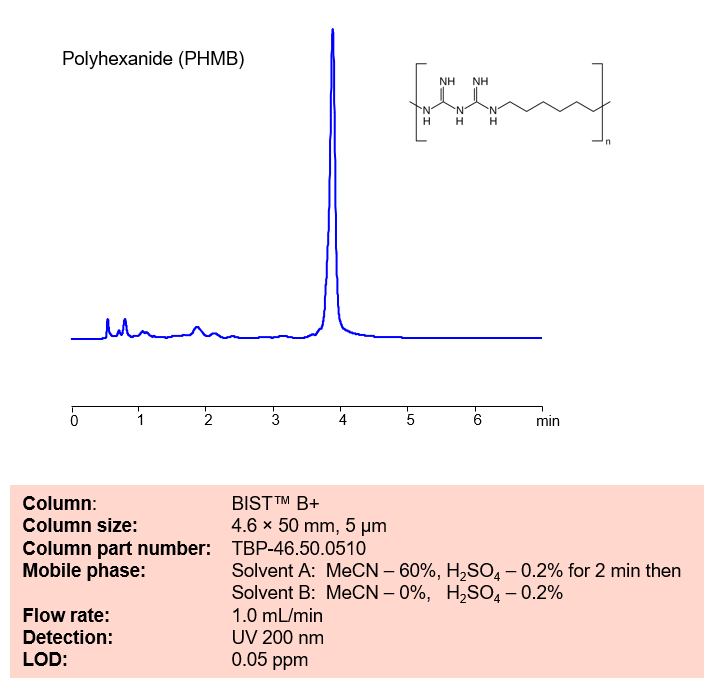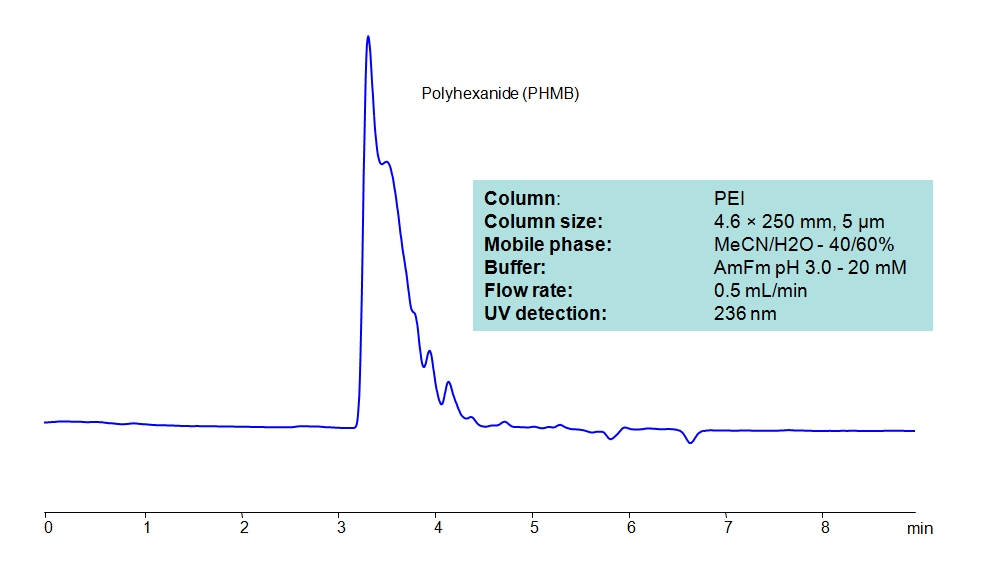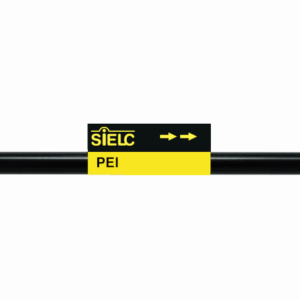| CAS Number | 28757-47-3 |
|---|---|
| Molecular Formula | C8H19N5 |
| Molecular Weight | 185.27 |
| InChI Key | VAZJLPXFVQHDFB-UHFFFAOYSA-N |
| LogP | 0.5 |
| Synonyms |
|
Applications:
HPLC Method for Separation Alexidine and Polyhexanide on BIST B+ Column
January 23, 2024
High Performance Liquid Chromatography (HPLC) Method for Analysis of Polyhexanide PHMB, Alexidine on BIST B+ by SIELC Technologies
Separation type: Bridge Ion Separation Technology, or BIST™ by SIELC Technologies

Alexidine and polyhexanide are both antiseptic agents used for various applications, particularly in the field of medicine and healthcare.
- Alexidine:
- Usage: Alexidine is a bisbiguanide antiseptic that is often used in oral care products, such as mouthwashes and dental formulations.
- Antimicrobial Properties: It has broad-spectrum antimicrobial properties, effective against bacteria, fungi, and some viruses.
- Application: Alexidine has been studied for its use in controlling oral biofilm and preventing dental plaque.
- Polyhexanide:
- Usage: Polyhexanide is a polymeric biguanide antiseptic that is used in various medical applications, including wound care and disinfection.
- Antimicrobial Properties: Similar to alexidine, polyhexanide has broad-spectrum antimicrobial properties and is effective against bacteria, fungi, and some viruses.
- Application: Polyhexanide is commonly used as an antiseptic solution for wound irrigation and for the treatment of infected wounds. It can also be found in some contact lens solutions.
Both alexidine and polyhexanide belong to the biguanide class of antiseptics, and they are known for their effectiveness against a wide range of microorganisms. The specific applications and formulations may vary based on the intended use, and these agents are often used in healthcare settings to prevent infections.
Alexidine and polyhexanide can be retained, separated and analyzed on a BIST B+ mixed-mode stationary phase column using an analytical method with a simple mobile phase of water, Acetonitrile (MeCN) , and a sulfuric acid as a buffer. This analysis method can be detected using UV at 200 nm.
High Performance Liquid Chromatography (HPLC) Method for Analyses of Polyhexanide PHMB, Alexidine
Condition
| Column | BIST B+, 4.6 x 150 mm, 5 µm, 100 A, dual ended |
| Mobile Phase* | Step Gradient A: MeCN – 75%, H2SO4 – 0.1% / 3 min B: MeCN – 0%, H2SO4 – 0.1% / 6 min |
| Buffe | H2SO4 -0.1% |
| Flow Rate | 1.0 ml/min |
| Detection | UV 200 nm |
| Sample | 1. 0.14 mg/ml 2. 0.26 mg/ml |
| LOD ** | 8 ppb, 10 ppb |
| Injection volume | 10 µl |
*The step gradient methods involve sudden changes in the solvent composition of the mobile phase, resulting in the baseline’s instability. It is necessary to account for this response to be able to interpret, integrate, and process results adequately. The blank sample (sample diluent) has to be analyzed before injecting the sample of interest. When all chromatograms are generated, it is necessary to subtract the blank chromatogram from the sample one before the integration step.
**LOD was determined for this combination of instrument, method, and analyte, and it can vary from one laboratory to another even when the same general type of analysis is being performed
Description
| Class of Compounds | Bis-biguanide |
| Analyzing Compounds | Polyhexanide PHMB, Alexidine |
Application Column
BIST B+
Column Diameter: 4.6 mm
Column Length: 150 mm
Particle Size: 5 µm
Pore Size: 100 A
Column options: dual ended
Polyhexanide PHMB

HPLC Method for Analysis of Polyhexanide (polyhexamethylene biguanide, PHMB) on BIST B+
November 30, 2022
HPLC Method forAnalysis of Polyhexanide (polyhexamethylene biguanide, PHMB) on BIST B+ by SIELC Technologies.
Separation type: Bridge Ion Separation Technology, or BIST™ by SIELC Technologies

High Performance Liquid Chromatography (HPLC) Method for Analyses of Polyhexanide (polyhexamethylene biguanide, PHMB)
Polyhexanide (polyhexamethylene biguanide, PHMB) has multiple industrial, medical, biological and research applications. It has strong antiseptic properties that make this compound very useful for materials that could be a possible source of bacterial contamination. Using SIELC’s newly introduced BIST™ method, Polyhexanide (polyhexamethylene biguanide, PHMB) can be retained on a positively-charged anion-exchange BIST™ B+ column.
There are two keys to this retention method: 1) a multi-charged, negative buffer, such as Sulfuric acid (H2SO4), which acts as a bridge, linking the positively-charged analytes to the positively-charged column surface and 2) a mobile phase consisting of a majority of organic solvent (such as MeCN) to minimize the formation of a solvation layer around the charged analytes. Utilizing a step gradient to switch to a completely aqueous MP after 2 minutes allows for retention to occur while also preventing the method from being too long. Using this new and unique analysis method, PHMB can be separated, retained, and UV detected at 200 nm.
Condition
| Column | BIST B+, 4.6×50 mm, 5 µm, 100A |
| Mobile Phase | MeCN Step gradient |
| Buffer | H2SO4 – 0.2% |
| Flow Rate | 1.0 ml/min |
| Detection | UV 200 nm |
| Peak Retention Time | 3.3 min |
Description
| Class of Compounds | Polymers |
| Analyzing Compounds | Polyhexanide (polyhexamethylene biguanide, PHMB) |
Application Column
BIST B+
BIST™ columns offer a unique and effective way to achieve separations that were traditionally challenging or even impossible with other HPLC columns. With the use of a special mobile phase, these ion exchange columns provide very strong retention for analytes with the same charge polarity as the stationary phase, unlocking new chromatography applications. What makes BIST™ columns stand out is their proprietary surface chemistry, which results in superior selectivity, resolution, and sensitivity. These columns offer a simple, efficient solution for a variety of analytical challenges, making them an excellent choice for researchers and analysts across many different fields. To learn more about the technology that powers BIST™ columns and to explore related applications, check out https://BIST.LC.
Select options
HPLC Determination of Polyhexanide (PHMB) on PEI Column
September 26, 2019
HPLC Method for Polyhexanide PHMB on PEI by SIELC Technologies
High Performance Liquid Chromatography (HPLC) Method for Analysis of Polyhexanide PHMB
Polyhexanide (polyhexamethylene biguanide, PHMB) is a polymer used as a disinfectant and antiseptic. We estimated that limit of detection is about 2 ppm for this compounds with this method.
The peak of polyhexanide fractionated on several peaks due to difference in length of the polymer components.
| Column | PEI, 4.6 x 250 mm, 5 µm, 100 A, dual ended |
| Mobile Phase | MeCN/H2O – 40/60% |
| Buffer | AmFm pH 3.0- 20 mM |
| Flow Rate | 0.5 ml/min |
| Detection | UV, 236 nm |
| Class of Compounds |
Polymer, Hydrophilic, Ionizable, Antiseptic, Disinfectant |
| Analyzing Compounds | Polyhexanide PHMB |
Application Column
PEI
Column Diameter: 4.6 mm
Column Length: 250 mm
Particle Size: 5 µm
Pore Size: 100 A
Column options: dual ended





